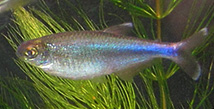| Boehlkea | |
|---|---|
 | |
| Cochu's blue tetra (Boehlkea fredcochui) | |
| Scientific classification | |
| Kingdom: | Animalia |
| Phylum: | Chordata |
| Class: | Actinopterygii |
| Order: | Characiformes |
| Family: | Stevardiidae |
| Subfamily: | Diapominae |
| Genus: | Boehlkea Géry, 1966 [1] |
| Type species | |
| Boehlkea fredcochui Géry, 1966 [1] | |
Boehlkea is a genus of freshwater ray-finned fishes, characins, belonging to the family Stevardiidae. [1] The fishes in this genus are found in the Amazon basin in South America. [2]